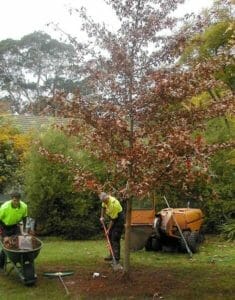 There are many reasons to move a tree. Perhaps you need to transplant because a tree is causing property devaluation in its current location. It might be interrupting the sewer line, scratching your home’s siding, or continually blocking drains with leaves. Or you might want to move a plant simply because the tree will work better in a different area on your property—with access to better sunlight, improved soil conditions, while bringing more enjoyment for your family. Finally, you might be bringing a plant to a new home.
There are many reasons to move a tree. Perhaps you need to transplant because a tree is causing property devaluation in its current location. It might be interrupting the sewer line, scratching your home’s siding, or continually blocking drains with leaves. Or you might want to move a plant simply because the tree will work better in a different area on your property—with access to better sunlight, improved soil conditions, while bringing more enjoyment for your family. Finally, you might be bringing a plant to a new home.
Whatever your reason, successful Portland tree planting demands good planning. You’ll need to figure out how large to make the planting hole, how to safely move a tremendously heavy tree, and how to place the tree in its new home. What’s more, you’ll need to prune the tree’s roots the season prior, to give feeder roots near the trunk a chance to develop.
It’s best to work with Portland certified arborists throughout the process, as they will be able to recommend the best approach for your specific location and tree. Not to mention their access to the equipment and experience needed for this task. An appropriately sized root ball for a tree with a three-inch diameter may weigh half a ton! Your average household’s shovel collection cannot handle the transplant of mature trees.
Without an expert on site, many transplants are doomed, due to improper removal or planting. For instance, it may seem logical to break up the soil at the bottom of the new hole—wouldn’t that make it easier for the roots to dig in? One might think so, but the truth is that breaking up underlying soil can actually cause the tree to sink later on, potentially leading to rot. Such common mistakes are easily avoided by working with an ISA-certified arborist.
One thing that all of our arborists can agree on is that Portland’s temperate autumn clime tends to be kind to recently transplanted trees. The wet, mild Oregon fall conditions minimize transplant shock. Fall also allows plenty of time for the plant to soak up nutrients and develop a strong root system. Autumn transplanting therefore supports healthy spring growth. To properly time your transplant, wait until there has been at least one hard freeze, and leaves are dropping. These are signs that the three is entering dormancy and is ready to be moved.
Transplanting with the Help of an Arborist
Transplanting is one of the more complex Portland tree services we offer. An arborist’s presence can smooth transplants by helping you avoid common mistakes, such as:
–Driving support stakes through tree roots,
–An improperly sized root ball,
–A root ball that’s set too low in the soil,
–Dropping the root ball, and
–Nitrogen fertilizing.
Overall, you can expect a tree transplant to require two hours, including digging out the tree, transferring it to a tarp, placing it in the hole, backfilling with soil, and creating an earthen berm under the drip line.
Urban Forest Pro’s arborists are ISA certified and experienced in local transplants. We can offer transplanting as an a la carte service, or, better yet, add it to an ongoing Portland tree care plan. Our arborists can advise you on which plants should only be moved in the spring, placement options, how frequently to water your new tree, how to monitor for signs of stress, and much more. Contact us today to schedule your fall transplant!